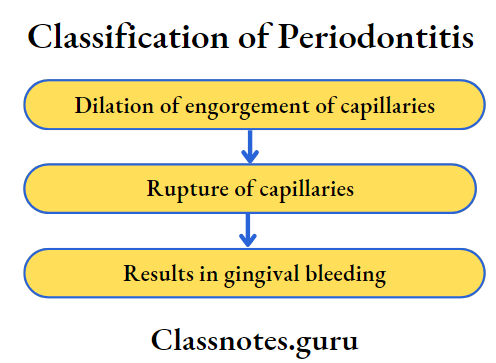Classification And Epidemiology Of Periodontal Diseases Short Essays
Question 1. Classification of Periodontal diseases. (or) AAP Classification.
Answer:
- By AAP 1999 (International Workshop for Classification of Periodontal Disease)
Gingival Disease:
Dental Plaque – Induced gingival disease:
- These diseases may occur on a periodontium with no attachment loss or on one attachment loss that is stable and not progressing.
1. Gingivitis associated with dental plaque only
- Without local contributing factors
- With local contributing factors
Read And Learn More: Periodontics Question and Answers
2. Gingival diseases modified by systemic factors
- Associated with the endocrine system
- Puberty associated gingivitis
- Menstrual cycle – associated gingivitis
- Pregnancy-associated
- Gingivitis
- Pyogenic granuloma
- Diabetes mellitus-associated gingivitis
- Associated with blood dysplasias
- Leukemia-associated gingivitis
- Others
3. Gingival diseases modified by medication
- Drug-influenced gingival diseases
- Drug-induced gingival enlargement
- Drug-induced gingivitis
- Oral contraceptive-associated gingivitis
- Others
4. Gingival diseases modified by malnutrition
- Ascorbic acid deficiency gingivitis
- Others
Non-plaque-induced gingival lesion:
1. Gingival diseases of specific bacterial origin
- Neisseria gonorrhea
- Treponema palladium
- Streptococcal species
- Others
2. Gingival diseases of viral origin
- Herpes virus infection
- Primary herpetic gingivostomatitis
- Recurrent oral herpes
- Varicella zoster
- Others
3. Gingival diseases of fungal origin
- Candida species infections, generalized gingival candidiasis
- Linear gingival erythema
- Histoplasmosis
- Others
4. Gingival lesions of genetic origin
- Hereditary gingival fibromatosis
- Others
5. Gingival manifestations of systemic conditions
- Subcutaneous lesions
- Lichen Planus
- Pemphigoid
- Pemphigus Vulgaris
- Erythema multiforme
- Lupus erythematosus
- Drug-induced
- Others
- Allergic reactions
6. Traumatic lesions (factitious, iatrogenic, or accidental)
- Chemical injury
- Physical injury
- Thermal injury
7. Foreign body reactions
8. NOT otherwise specified (MOS)
Chronic Periodontitis:
- Localized – Less than 30% of sites involved
- Generalized – More than 30% of sites involve
- Slight – 1 to 2 mm clinical attachment loss
- Moderate – 3 to 4 mm clinical attachment loss
- Severe – More than 5 mm clinical attachment loss
Aggressive Periodontitis:
- Localized – Slight, moderate, or severe
- Generalized -Periodontitis as a manifestation of systemic diseases.
1. Associated with hematological disease
- Acquired neutropenia
- Leukaemia
- Others
2. Associated with genetic disorders
- Familiar and cyclic neutropenia
- Down’s syndrome
- Cohen syndrome
- Hypophosphatasia
3. Necrotizing periodontal diseases:
- Necrotizing ulcerative gingivitis
- Necrotizing ulcerative periodontitis
4. Abscesses of the Periodontium:
- Gingival abscess
- Periodontal abscess
- Periocoronal abscess
Periodontitis associated with endodontic – Lesion End-period lesion:
Developmental/Acquired Deformities:
- Localized
- Mucogingival around teeth
- Mucogingival around edentulous ridges
- Occlusive trauma

Question 2. Plaque-induced gingival Inflammation.
Answer:
These diseases may occur on a periodontium with no attachment loss or on one attachment loss that is stable and not progressing.
1. Gingivitis associated with dental plaque only
- Without local contributing factors
- With local contributing factors
2. Gingival diseases modified by systemic factors
- Associated with the endocrine system
- Puberty associated gingivitis
- Menstrual cycle-associated gingivitis
- Pregnancy-associated
- Gingivitis
- Pyogenic granuloma
- Diabetes mellitus-associated gingivitis
- Associated with blood dysplasias
- Leukemia associated gingivitis
- Others
3. Gingival diseases modified by medication
- Drug-influenced gingival diseases
- Drug-induced gingival enlargement
- Drug-induced gingivitis
- Oral contraceptive-associated gingivitis
- Others
4. Gingival diseases modified by malnutrition
- Ascorbic acid deficiency gingivitis
- Others
Changes In Epithelium:
Presence of plaque bacteria → Destruction of intercell lar junctions → Loss of epithelium barrier → Entry of bacteria into connective tissue → Results in ulceration in the epithelium
Changes In Connective Tissue:

